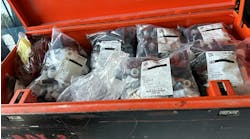Latest from Plumbing
Sponsored
According to Now magazine (dontcha just love British gossip rags?), the singer Beyonce spent $5,000 so that she her baby, Blue Ivy, could bathe in Evian water. Unfortunately, the good people of West Virginia and North Carolina don’t have that kind of money. If they did, they wouldn’t have to worry about corporations like Duke Energy poisoning their drinking water.
I’ve written twice before about coal-related drinking water contamination. The first time (Poisoning our water supply is not ok) was about when a storage tank at a company called Freedom Industries holding 48,000-gal. of the coal-washing chemical 4-methylcyclohexene methanol, or MCHM, ruptured right next to the Elk River, less than two miles from the intake to the water treatment plant for Charleston, W.Va. Approximately 10,000-gal. of the chemical spilled into the river during this January 2014 spill. The water supply for 300,000 people was put out of commission for everything except flushing toilets. West Virginia has regulations for chemical processing facilities but not for chemical storage facilities like the Freedom Industries facility. The storage site had reportedly not been inspected since 1991.
The second time (‘A poisoned ball spilling a trail of filth’) covered the rupturing of a pipe under a coal ash pond owned by Duke Energy, sending 82,000 tons of coal ash and 27 million gallons of tainted water into the Dan River, upstream from Danville, Va.
Duke has agreed with the Environmental Protection Agency that it will pay to clean up its mess, something they should have learned about in kindergarten, but the work has barely begun.
Writing in the New York Times (Smoke in the Water), Derb Carter, the director of the Chapel Hill, N.C., office of the Southern Environmental Law Center, points out that the Duke Energy coal ash pond responsible for the Dan River spill is the smallest one in the state. There are bigger coal ash ponds near Asheville and Charlotte. Picture that — Charlotte losing its drinking water supply for some indeterminate period.
I recently received an update from my previous correspondent, Hampton, Va., carpentry contractor Richard Amadon, who wrote, “I just read your column, dated May 4. Thank you for including comments that I sent in response to your April 4 column.”
There’s still no end in sight to what the people in West Virginia, addicted as they are to clean drinking water, have to put up with. Richard was kind enough to supply a list of some of the latest coverage by local news outlets that are doing a terrific job covering this debacle.
“Here are some related news items (with partial quotes) from our local news outlets,” Amadon says. “It would be a comedy of errors, except that it isn’t funny.”
HURRICANE, W.VA. — Hurricane’s mayor doesn’t want his town to become the dumping ground for Charleston’s problem. Mayor Scott Edwards learned this week trucks loaded with water contaminated with MCHM were being trucked by Freedom Industries to the DSI Landfill in Hurricane for disposal.
Edwards first learned about the dumping which began March 7 through a phone call and mounting reports of the licorice odor in the area.
“Their leachate actually gets piped into the Hurricane wastewater treatment plant,” Edwards said. “We don’t treat for MCHM so all of that gets piped right into Hurricane Creek. I have major concerns for all of this.”
ST. ALBANS, W.VA. — Federal and state investigators are looking into a suspected chemical leak at the Kanawha County location for the company that’s transported MCHM for Freedom Industries. Those with the DEP said a “sheen” from an unidentified chemical was found in a drainage system near the company’s facility. That drainage system runs into a tributary of the Kanawha River.
CHARLESTON, W.VA. — The state Department of Environmental Protection hopes to begin dismantling the steel storage tanks at the Freedom Industries site in Charleston by June 1. ... The DEP said shipments of wastewater from the Freedom site are continuing to both North Carolina and Ohio wastewater treatment facilities. There is currently 756,000 gallons of the wastewater than came from storm water runoff collected in trenches and pumped into tanks at the Freedom site. The DEP said the amount fluctuates depending on rain and the hauling schedule.
Amadon goes on to note that after the tank farm is removed, then the contaminated soil will have to be dealt with.
“One would have to assume that the MCHM from the original leak (the duration of which is apparently unknown; the number of gallons leaked has been estimated to have been 10,000) hugged the shoreline of the Elk River as it made its way downstream to its confluence with the Kanawha River,” Amadon says. “I don’t know how much of the Elk River shoreline downstream from the tank farm has been tested for contamination.
“The feeling around here is that these guys just happened to get caught because of the unusual licorice-like odor of MCHM, and that spills like this probably occur all of the time,” he continues. “Many wonder what else goes into our water. There are hundreds (if not thousands) of chemicals for which no testing or treatment is being done at water treatment plants. I realize that there is no way to test for everything, so it all goes back to those that are responsible for storing and using the chemicals. As this incident has demonstrated, there is also more required on the part of regulating agencies. That is not to say that more rules and regulations are necessarily needed, but that more stringent inspections and enforcement could be in order. A 4-in. and an 8-in. inch hole do not just happen overnight. And dikes for containment should actually contain. How likely is it that no one saw the potential for a disaster? If indeed no one did see the potential, why not?
“We’re a sparsely populated state with small cities and towns. One can only imagine what’s going on in the rest of the country and around the world.
“Again, thanks for your excellent columns. Keep up the good work.”
Thank you, Richard. I will. And if you read or hear more on this topic, please let us know.
***
Being on the plumbing side, I don’t get into air pollution, but I wanted to point out a couple items of interest coming from the EPA’s power plant emissions rule. I’m not going to get into that at length; you can click the links to keep reading.
The U.S. Chamber of Commerce estimates the pollution rules will cost the U.S. economy $50 billion a year, which sounds like a lot except we have a $17 trillion economy. When you do the arithmetic, $50 billion is 0.29%. A Washington Post/ABC News poll showed that 70% of the public is in favor of the rules, including 63% of Republicans, even if it costs them $20 a month. House Speaker John Boehner said, “The President’s plan is nuts.” And Kentucky Sen. Rand Paul has vowed to repeal the “illegal” EPA climate rule.
Robert Mader Blog | Editor in Chief
Bob Mader is the editor of CONTRACTOR magazine, Green Mechanical Contractor magazine, and Radiant Living magazine. He has been writing about plumbing, mechanical, green building and HVACR topics for more than 25 years.

